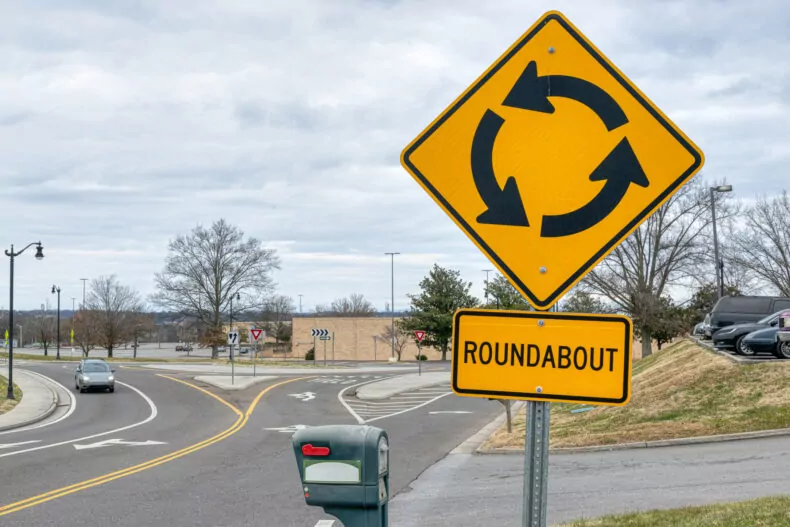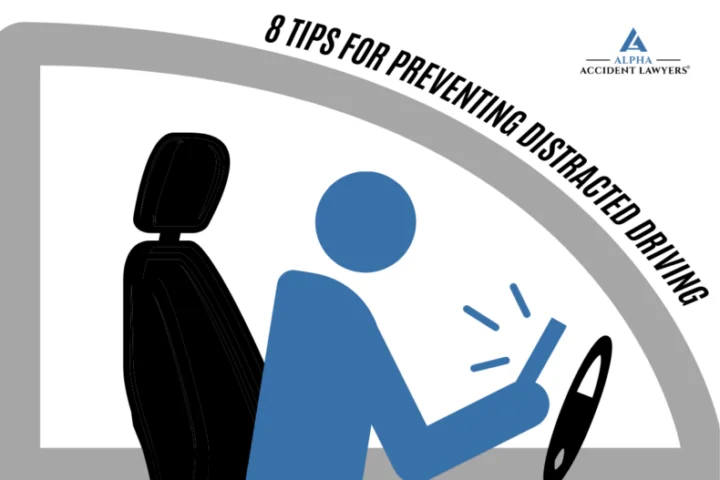All You Need to Know About Roundabout Accidents
As of 2021, there are 8,800 roundabouts in the United States. The Federal Highway Administration reports about one-third of all traffic fatalities occur at traditional traffic light intersections. Roundabout accidents are considerably less severe and occur at a lower rate. Studies show that converting traffic signals and stop signs to roundabouts reduces injury crashes by 72% to 80% and any crash risk by 35% to 47%.
This is because the average roundabout has only eight potential areas for a collision. There are 32 collision points in a standard four-way intersection.
Wisconsin has more roundabouts than any other state. Their 500 traffic circles reduce traffic fatalities and save the state about $5,000 in electricity costs. As more states make the change, there is the potential for a traffic circle accident to occur.
If you get nervous when approaching a roundabout, keep reading. We will share how to use a roundabout, explain when you are most likely to get into a roundabout car accident, and discuss steps to take following an accident.
Using a Roundabout
Roundabouts are circular intersections that promote safety and keep traffic flowing. Vehicles approach, wait for an opening in the traffic flow, then enter the roundabout. All automobiles travel in a counterclockwise direction.
People unfamiliar with roundabouts may be hesitant or need help understanding who has the right-of-way or which lane to use. Vehicles entering the traffic circle must yield before entering; circling traffic has the right-of-way.
Because everyone travels in the same direction at a low speed, the most severe personal injury auto accidents are less likely to happen. Most car crashes occur when a vehicle merges into the circle or attempts to exit from the wrong lane of a multi-lane roundabout.
When approaching a multi-lane traffic circle, watch for a sign indicating which lane you need to exit at the appropriate point. Don’t worry if you get confused and need to drive the circle several times. Mistakes happen, and the key to safety is ensuring you are in the proper lane when exiting.
Even if you feel confused at first, you will become comfortable with traffic circles and traffic flow with practice. You can enter roundabouts knowing you are safer than at a standard intersection.
In the United States, two people die every day because a vehicle runs a red light. A study found that using roundabouts in 2018 would have prevented 51,000 crashes, including 231 fatalities and 34,000 injuries.
Common Causes of Roundabout Accidents
Even though the roundabout is a unique roadway for traffic flow, standard right-of-way protocols exist for pedestrians and bicycles. You are less likely to encounter pedestrians in a roundabout circle, but it is possible. Bicycles have the same rights as an automobile when using roundabouts, so watch for them in the circle to avoid an accident.
Speeding
When entering a roundabout, reduce your speed. The average roundabout speed is about 20 mph. Traveling faster than the posted rate of speed puts everyone in the circle at risk.
Stopping
Once you enter the roundabout and are circling, you have the right of way. Do not stop when a vehicle approaches outside the circle.
Doing so may result in a rear-end collision. Everyone in the circle expects traffic to continue flowing.
While drivers must be aware of their surroundings and completely control their vehicle at all times, police may consider you the at-fault driver for making an unnecessary sudden stop. Depending on the amount of traffic inside the circle, this can quickly spiral into a multi-vehicle collision.
Large Vehicles
Large vehicles going through roundabouts may experience difficulty because of the limited turning radius of a traffic circle. Tractor trailers, large box trucks, motorhomes, and vehicles towing trailers need more space and have significant blind spots.
These vehicles may need to move into an outer lane to make a turn in a roundabout. Always be aware of large vehicles in the traffic circle and give them ample space to maneuver.
Do not try to cut around these vehicles or prevent them from changing lanes when necessary. Defensive driving prevents accidents.
Improper Lane Changes
Follow the instructions of signs and roadway markings to make sure you exit from the proper lane. If you suddenly cross another vehicle’s path to exit, you may cause a collision.
If possible, avoid lane changes within the circle. If you must change lanes, it is better to circle the roundabout a few times until you can safely move over rather than rushing and causing an accident.
Failure to Yield
You must yield to traffic already in the circle when approaching a roundabout. This means all traffic coming from the left, including bicyclists, regardless of which lane they are in.
Once inside the circle, you do not stop to allow others to enter. You have the right-of-way, and stopping may cause a collision.
Not Using Signals
Roundabouts do not eliminate the need to use your turn signal. Other vehicles need to know when you are exiting or changing lanes.
The key points to preventing a roundabout car crash are to comply with the recommended speed, use signals, and stay alert to potential hazards.
Determining Fault in a Roundabout Accident
The traffic traveling within the roundabout has the right-of-way. That means if you are in the circle and another driver tries to speed around you or enter when unsafe, they will likely be at fault.
You must follow at a safe distance, even at the reduced roundabout speed. Sometimes, a driver making a sudden stop without reason can be at fault. Most of the time, the vehicle in the rear is liable for the accident.
If a person changes lanes within a traffic circle and an accident occurs, that person is likely at fault. That is why it is important to enter the proper lane immediately. Lane changing in a circle is tricky because of constant blind spots.
Following a Roundabout Accident
If you are in a roundabout accident, there are important steps you need to take at the scene. Make sure everyone is okay, then call the police. You can then begin collecting evidence.
Take pictures of the accident before any vehicles move. This is crucial evidence to prove your case if an insurance claim is denied or the other person accuses you of being at fault. Photographs can also help police determine fault if vehicles are moved off the road before they arrive.
If there are witnesses, get their information before they leave the scene. Even if all you have is a name, email or phone number, and a simple statement about what they saw, this can help prove your case.
If you suffer any injuries in the accident, seek immediate medical attention. Even if you believe your injuries to be minor, things such as whiplash sometimes do not appear until hours later. The faster you receive medical treatment, the faster your recovery, and the easier it is for a car accident personal injury attorney to prove your case.
Call an Auto Accident Attorney
Roundabout accidents, though often minor, may result in personal injuries. Contact Alpha Accident Lawyers to schedule a free consultation if you suffer injuries in an automobile accident. We will evaluate your case and take the necessary steps to get you the compensation you deserve.





